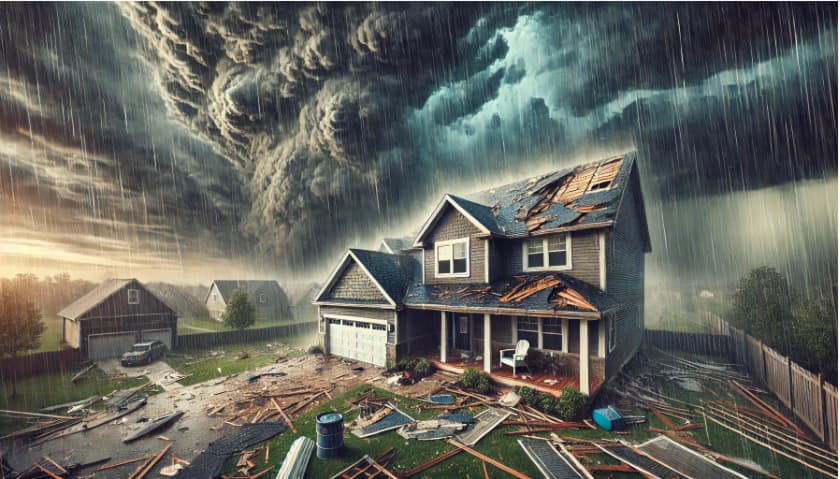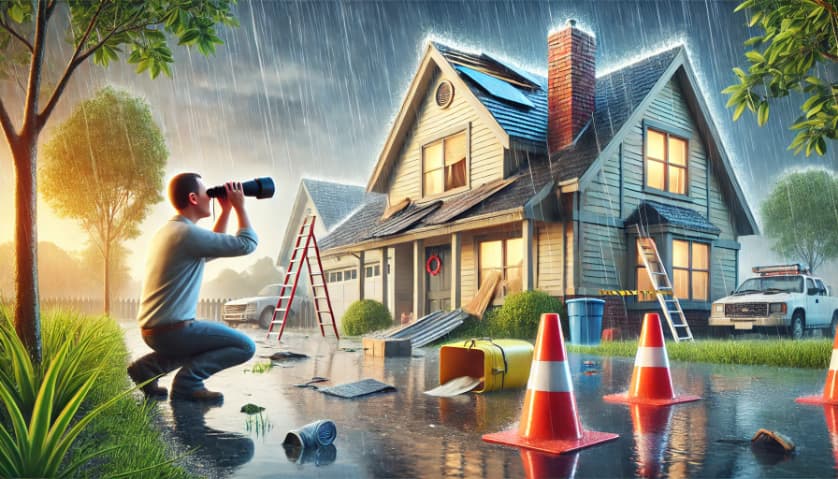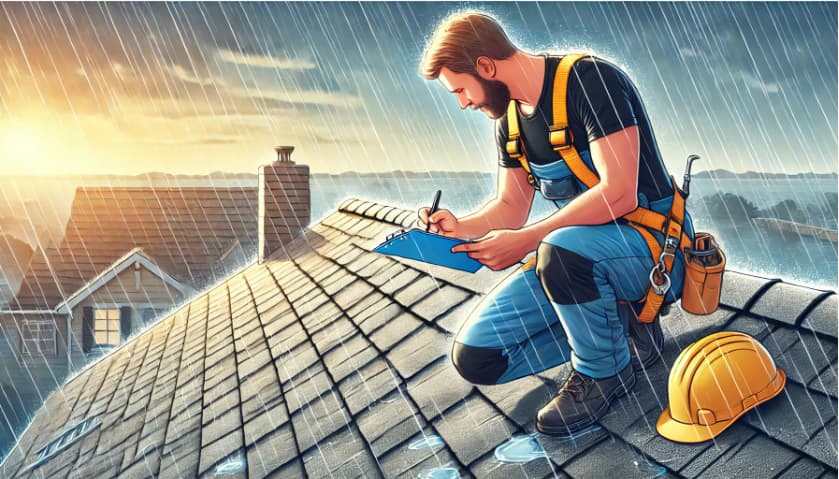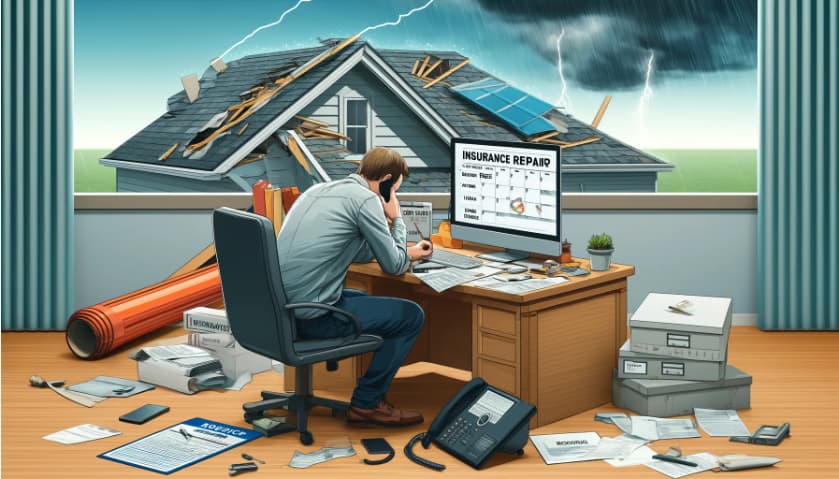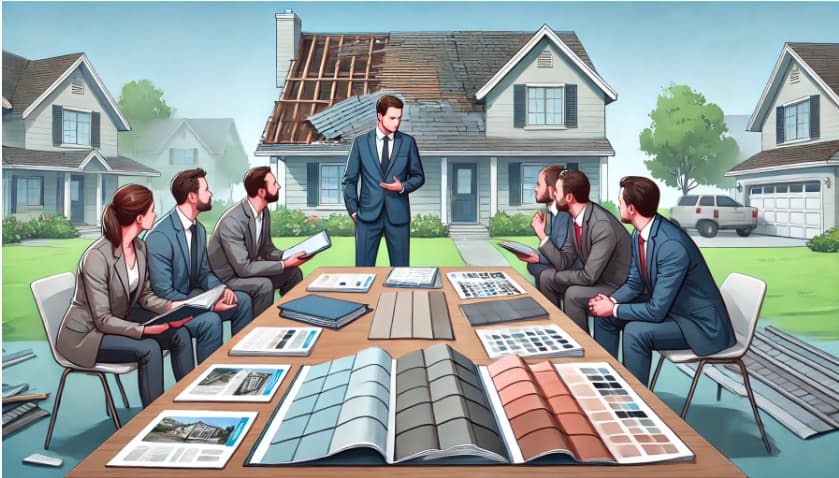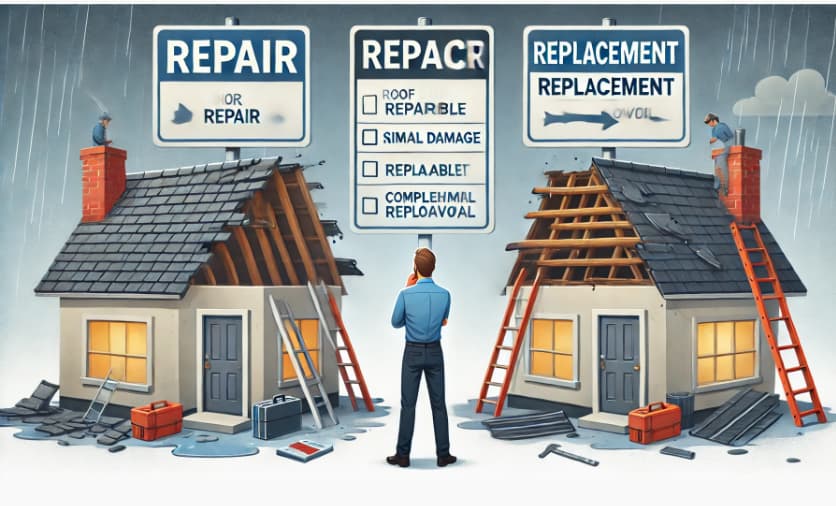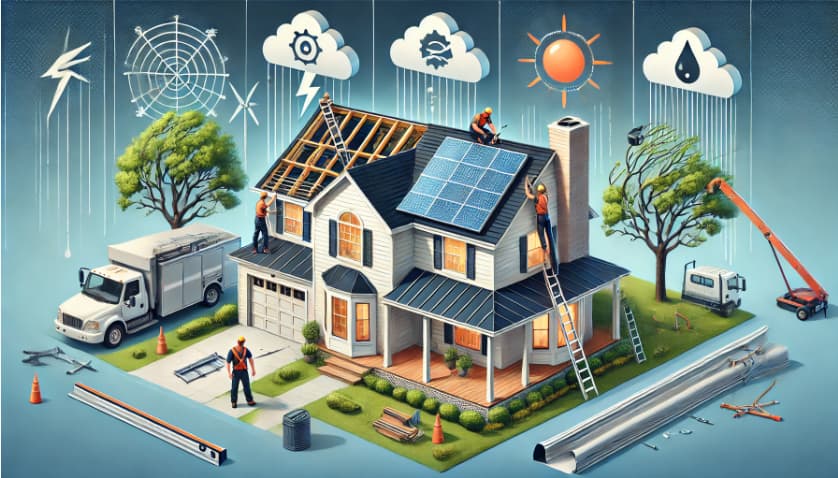Repair
Roof Storm Damage Repair: Quick Recovery Tips
Roof Storm Damage Repair? Storms in the United States vary widely from tornadoes in the Midwest to hurricanes along the coast, each bringing its own brand of havoc, especially to roofs.
Understanding the risks and knowing how to react quickly can protect your home from extensive damage.
Immediate action after a storm can prevent further complications, making the difference between minor repairs and a full-scale roof replacement.
2: Immediate Steps After Storm Damage
When a storm subsides, the first step is a visual inspection from the ground. Look for obvious signs of distress such as missing shingles, damaged flashing, or fallen branches.
This quick check helps you understand the extent of damage. Always prioritize safety avoid climbing the roof during or immediately after the storm as it’s both dangerous and can cause further damage to a weakened structure.
Next, secure your property. If safe, cover any breaches with a tarp to prevent water from entering the home. This temporary solution can save thousands in water damage but remember it’s a short-term fix.
Not sure if your roof weathered the storm? Click here for a professional inspection and peace of mind.
3: Understanding Types of Roof Storm Damage
Storm damage to roofs can manifest in several forms, each with unique challenges and repair needs:
- Wind Damage:
Winds, particularly during hurricanes and tornadoes, can exceed 74 mph and rip shingles right off the roof.
Even less intense winds can lift or curl shingles, compromising the roof’s integrity by breaking the watertight seal, potentially leading to internal water damage during subsequent rain.
Hail Damage:
Hail can be deceptive because it often leaves behind subtle signs that are hard to detect without a close inspection.
Hailstones can knock off the granules from shingles, which protect against rain and sun, thereby reducing the lifespan of your roof.
Water Damage:
Poor drainage or clogged gutters can lead to standing water on your roof, which can seep through and cause significant damage over time.
Ensuring proper water flow off your roof is critical to maintaining its integrity.
Debris Damage:
Storms can scatter branches, leaves, and other debris that can scratch, dent, or puncture the roofing material.
Significant impacts, such as from large tree limbs, can necessitate immediate repairs to prevent moisture ingress.
Concerned about the hidden signs of storm damage on your roof? Discover how to spot and fix them before they lead to major repairs!
4: The Roof Inspection Process
After a storm, a thorough roof inspection is crucial to assess any damage accurately.
This should ideally be done by a professional roofing contractor who can safely identify issues that might not be obvious to the untrained eye. During an inspection, the contractor will:
- Check for missing, damaged, or curling shingles.
- Inspect for signs of hail damage, such as pockmarks or granule loss.
- Evaluate the condition of flashing, vents, and chimneys.
- Look for standing water or poor drainage areas that could lead to future problems.
- Examine the gutters and downspouts for blockages or damages.
Photographic evidence from these inspections can be invaluable, especially if you need to file an insurance claim.
The contractor can also provide a detailed report that will help in determining the next steps, whether it’s immediate repairs or a full replacement.
Not sure what’s lurking on your roof after that last big storm? Schedule a professional inspection today and ensure your home is protected!
5: Navigating the Insurance Claim Process
Navigating the insurance claim process after storm damage can be complex and confusing. Here’s what you need to know:
- Initial Contact: As soon as you notice damage, contact your homeowner’s insurance provider to report the issue. Early reporting is crucial for timely claims processing.
Documentation: Gather as much evidence as possible. This includes taking photos of the damage, noting the date of the storm, and documenting any temporary measures you’ve taken to protect your property.
Adjuster Inspection: An insurance adjuster will visit your home to assess the damage and determine the claim’s validity. It’s crucial to have all your documentation ready and to discuss your findings with the adjuster.
Claim Approval: If your claim is approved, your insurance will cover the costs of repairing the damage, subject to your policy’s terms.
If your claim is denied, you can request a re-assessment or consider a second opinion from an independent contractor.
Struggling with your roof damage claim? Let us guide you through the insurance maze to ensure you get what you deserve.
6: Selecting a Roofing Contractor
Choosing the right roofing contractor is critical to ensuring your roof is properly repaired or replaced. Here’s how to select the best one:
- Credentials: Look for licensed and insured contractors with solid references. Credentials are a baseline for trust and quality assurance.
Experience with Insurance Claims: Contractors experienced with insurance claims may help navigate the complexities of claim filing and ensure the insurance pays out appropriately.
Quality of Work: Review previous work samples and testimonials. High-quality contractors will have no issues showcasing their work.
Estimates: Get detailed written estimates. These should include the scope of work, materials to be used, timelines, and payment terms.
Need a reliable roofing contractor but not sure where to start? Check out our trusted partners and secure your home today.
7: Repair vs. Replacement
Deciding whether to repair or replace your roof after storm damage involves several factors:
- Extent of Damage: Minor damage like a few missing shingles usually just requires repairs. Extensive damage affecting the roof’s structure might necessitate a full replacement.
Age of Roof: Older roofs nearing the end of their expected lifespan may be better candidates for replacement rather than repeated repairs.
Cost Considerations: While repairs might be cheaper in the short term, a new roof can improve home energy efficiency and offer long-term savings.
Insurance Coverage: Your policy details and the nature of the damage will influence whether insurance recommends repair or replacement.
Making the right decision requires weighing the immediate costs against the long-term benefits and risks.
Not sure whether to repair or replace your storm-damaged roof? Learn more about your best options and get expert advice here!
8: Preventative Measures for Future Storms
To minimize future storm damage to your roof, consider these preventative measures:
- Regular Inspections: Schedule inspections at least twice a year and after every major storm to catch and fix small issues before they worsen.
Quality Materials: When repairs or replacements are necessary, choose high-quality, durable materials suited for your climate.
Proper Installation: Ensure that installation or repairs are performed by certified professionals, as poor workmanship can increase vulnerability to weather.
Tree Trimming: Keep trees around your home trimmed to prevent branches from falling on your roof during a storm.
Investing in these preventative measures can significantly extend the life of your roof and reduce the likelihood of severe damage in future storms.
Ready to storm-proof your roof but not sure where to start? Check out our preventative maintenance services and protect your home today!
9: Legal and Regulatory Considerations
Navigating the legal and regulatory landscape is crucial when repairing or replacing a storm-damaged roof. Here’s what you need to consider:
- Local Building Codes: Familiarize yourself with local building codes that dictate the materials and methods used in roof construction. Compliance ensures safety and avoids legal complications.
Permits: Most significant roofing work will require a permit from local authorities. Your contractor should manage this process, ensuring that all work is inspected and approved.
Contractor Compliance: Verify that your contractor is licensed and insured according to state laws. This protects you against liability and ensures a standard of workmanship.
Historic Preservation: If your home is in a historic district, additional regulations may govern your roofing options to maintain the area’s architectural integrity.
Understanding these factors helps safeguard your investment and ensures that the roofing work meets all necessary standards and regulations.
Concerned about the legal aspects of your roofing project? Ensure your roof repair complies with local laws by consulting our experts.
Conclusion
Choosing the right steps after storm damage to your roof can seem daunting, but with the right knowledge and assistance, you can navigate the process smoothly.
From assessing the damage and handling insurance claims to selecting the right contractor and understanding legal requirements, each step is crucial for restoring your home’s safety and aesthetics efficiently and effectively.
Remember, the resilience of your roof against future storms depends significantly on the quality of repair and preventative measures taken now.
Ready to repair your storm-damaged roof with confidence? Contact our expert team today and start with a comprehensive roof evaluation.
Dealing with roof storm damage can be daunting, but taking the right steps quickly helps mitigate further issues. Remember, the key to recovery is prompt actions and informed decisions. Check your options today
Recent Posts
- Emergency Roof Leak Repair : Quick Protection Tips
- Roof Leak Repair: Quick Guide to Protect Your Home
- Fibreglass Roofing: Unlocking Durability and Style
- Roof Replacement Essentials: Protect Your Home
- Metal Roofing Types and Colors: Explore Top Styles & Trends

